- Products
- PoE Media Converters and Switches
- Ethernet & PoE Switches Product Selector
- Multi-Gigabit Ethernet and PoE Switches
- PoE PSE Commercial Switches
- PoE PSE Industrial Fiber Switches
- PoE Industrial Copper Extenders
- PoE Powered Media Converters
- PoE PSE Media Converters
- PoE Extenders & Injectors Product Selector
- Pluggable Transceivers Product Selector
- Product Lines
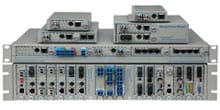
- iConverter Managed Multi-service Platform
- Copper to Fiber Media Converters
- Ethernet Media Converters
- 10 Gigabit Copper-to-Fiber
- 10/100/1000 Copper to 10 Gigabit Fiber
- 10/100/1000 Copper-to-Fiber with Integrated Management
- 10/100/1000 Industrial Copper-to-Fiber with Integrated Management
- 10/100/1000 Copper-to-Fiber with VLAN
- 10/100/1000 Dual Media Converter with VLAN
- Gigabit Copper-to-Fiber
- 10/100 Copper-to-Fiber with Integrated Management
- 10/100 Industrial Copper-to-Fiber with Integrated Management
- 10/100 Copper-to-Fiber with VLAN
- 10/100 Copper-to-Fiber
- Fast Ethernet Copper-to-Fiber
- Fast Ethernet Redundant Links
- 10Mbps Copper-to-Fiber
- 10Mbps Copper to Coax
- TDM Media Converters
- Serial Media Converters
- Ethernet Media Converters
- Fiber to Fiber Media Converters
- 10 Gigabit Fiber-to-Fiber Converter and Transponder
- 10 Gigabit Industrial Converter and Transponder
- SFP-to-SFP Fiber Converter and Transponder
- SFP-to-SFP Industrial Fiber Converter and Transponder
- Gigabit Fiber to-Fiber with 3 Rs
- 100/1000 Fiber-to-Fiber with 3 Rs
- Gigabit Fiber-to-Fiber
- Fast Ethernet Fiber-to-Fiber with 3 Rs
- Fast Ethernet Fiber-to-Fiber
- OC-3/STM-1 Fiber-to-Fiber
- OC-12/STM-4 Fiber-to-Fiber
- Carrier Ethernet Network Interface Devices
- CE 2.0 - 10G Demarcation NID
- CE 2.0 - 10G Demarcation and Aggregation NID
- CE 2.0 - 10/100/1000 Mult-port NID
- CE 2.0 - 10/100/1000 Mult-port NID with PoE
- CE 2.0 - 10/100/1000 8-Port NID
- SFP NID - Gigabit SFP NID
- microNID - 100/1000 compact NID
- CE 1.0 Service OAM - 10/100/1000 NID
- CE 1.0 Link OAM - 10/100/1000 Copper-to-Fiber NID
- CE 1.0 Link OAM - 10/100 Copper-to-Fiber NID
- CE 1.0 Link OAM - Gigabit Fiber-to-Fiber NID
- CE 1.0 Link OAM - Fast Ethernet Fiber-to-Fiber NID
- CWDM Multiplexers
- T1/E1 Multiplexers
- Ethernet Switch Modules
- Management System
- Chassis Options

- 1-Module Industrial Chassis

- RuggedNet Industrial Switches and Extenders
- Industrial PoE PSE Fiber Switches
- Multi-Gigabit Managed Industrial PoE+/BT Switches
- Multi-Gigabit Unmanaged Industrial PoE+/BT Switches
- 10G Managed 802.3bt PoE Switches
- 10G Unmanaged 802.3bt PoE Switches
- 10G Managed PoE+ Switches
- 10G Unmanaged PoE+ Switches
- 1G Managed PoE+ Switches
- 1G Unmanaged PoE+ Switches
- 1G Unmanaged 802.3bt PoE Switches
- 1G Managed 802.3bt PoE Switches
- Industrial Ethernet Switches
- Industrial PoE Copper Extenders
- Industrial Power Supplies

- OmniConverter Media Converter, Switches and Extenders
- PoE PSE Media Converters
- 10G Multi-Gigabit / Multi-Rate PoE Media Converter
- 10G Multi-Gigabit / Multi-Rate Media Converter
- 10/100 Multi-port PoE+ Media Converter
- 10/100 PoE+ Media Converter
- 10/100/1000 Multi-Port PoE+ Media Converter
- Industrial 10/100/1000 Multi-Port PoE+ Media Converter
- 10/100/1000 PoE+ Media Converter
- 10/100/1000 PoE++ 60W-100W Media Converter
- Industrial 10/100 Multi-port PoE+ Media Converter
- 1U Rack-Mount Shelf
- PoE PSE Compact Switches
- Multi-Gigabit Managed PoE+/BT Switches
- Multi-Gigabit Unmanaged PoE+/BT Switches
- 10G Managed 802.3bt PoE Switches
- 10G Unmanaged 802.3bt PoE Switches
- 10G Managed PoE+ Switches
- 10G Unmanaged PoE+ Switches
- 1G Managed PoE+ Switches
- 1G Unmanaged PoE+ Switches
- 1G Managed 802.3bt PoE Switches
- 1G Unmanaged 802.3bt PoE Switches
- Ethernet Switches
- PoE Copper Extenders
- Single Pair Ethernet Converters
- PoE Injectors
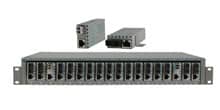
- miConverter Unmanaged Miniature Media Converters
- 10/100/1000 Copper-to-Fiber
- Industrial 10/100/1000 Copper-to-Fiber
- 10/100/1000 Ultra-Compact Copper-to-Fiber
- Gigabit Copper-to-Fiber
- 10/100/1000 Copper-to-Fiber PoE Powered
- 10/100 Copper-to-Fiber
- 10/100 Ultra-Compact Copper-to-Fiber
- 10/100 Copper-to-Fiber PoE Powered
- 18-Module Chassis
- Industrial 10/100 Copper-to-Fiber PoE Powered

- FlexSwitch Compact Switches
- Solutions
- Company
- Support
- How to Buy
Choosing the Best Network switch for VOIP
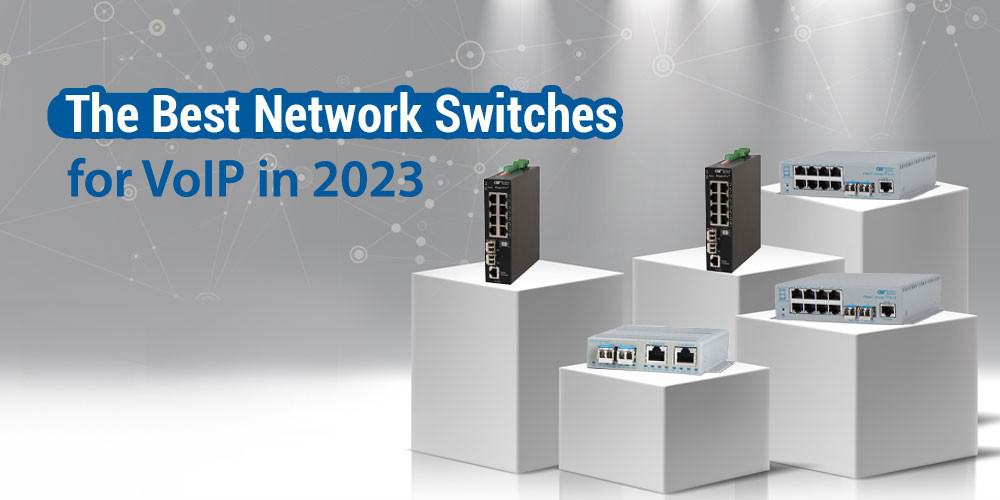
Everything that you need to know about finding the best network switch for VoIP phones is summed up in this ultimate guide.
VoIP or Voice over Internet Protocol, and VoIP phones come in various types, such as PoE VoIP or non-PoE VoIP. Connecting VoIP phones over long distances with copper cabling becomes a challenge. In each part, we discuss these powering and distance issues. By the end, you will have the answer to the question: How can I get the most cost-efficient and compatible network switch for VoIP phones?
Network Topology
Network topology is the way computers are arranged and located inside the network, how they are connected and communicate with each other, and the design of the equipment placed in the network.
When we want to add a switch to our network, the most common network topology is going to be the star topology. All systems are connected to the central switch, Ethernet switch, or PoE switch by Fiber Optic or UTP (Unshielded Twisted Pair) cables. All devices operate independently of each other because each device is connected to the central switch by a separate cable. When one system is disconnected, it doesn't affect the other. You can easily add more computers and devices to the star topology.
Ethernet Switches for VoIP
VoIP (Voice over Internet Protocol) phones connect to the Ethernet switch over an Ethernet cable for voice communication. Per the IEEE specification, the maximum distance for Ethernet on a copper cable is 100 meters. For connecting the VoIP phones to the Ethernet switch, the Ethernet cable needs to be Cat5e or better. What is Cat5e? Cat is the short form of “category” for copper cables, which defines the thickness of the wire, the number of pairs (2 pairs or 4 pairs), and how tightly each pair is twisted. Read the table below to understand why the cable should be Cat5e or better.
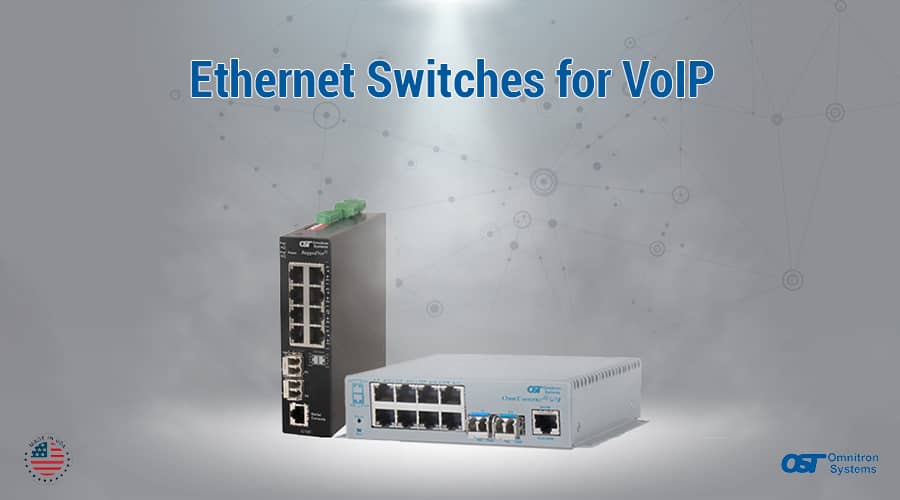
| Category | Number of pairs | Speed | Bandwidth Frequency | Distance | Cable type |
|---|---|---|---|---|---|
|
Cat5 |
4 pairs |
100Mbps |
100MHz |
100m |
UTP |
|
Cat5e |
4 pairs |
1000Mbps |
100MHz |
100m |
UTP |
|
Cat6 |
4 pairs |
10Gbps |
250MHz |
55m |
UTP/STP |
|
Cat6a |
4 pairs |
10Gbps |
500Mhz |
100m |
STP |
|
Cat7 |
4 pairs |
10Gbps |
600MHz |
100m |
STP/FTP |
|
Cat8 |
4 pairs |
25Gbps |
2GHz |
30m |
STP |
*STP = Shielded Twisted Pair
*FTP = Foiled Twisted Pair
PoE Switches for VoIP
The advanced models of VoIP phones (Voice over Internet Protocol) require a PoE switch for the association of both power and data network connection. PoE is a technology that combines data and power simultaneously over Ethernet cables. The PoE switch is a type of network switch that supports PoE technology. The most basic type of PoE is IEEE 802.3af (PoE), which provides 12.97W power to powered devices (PDs). PoE switches come in three forms: PoE/ PoE+ and PoE++/ HPoE. Typical VoIP phones require less than 7W of power that can be derived from a PoE/PoE+ capable PoE switch. However, if you want to connect other powered devices to the PoE switch, you might be better off considering the PoE++/HPoE PoE switch. The cables are important too. As the PoE sends power and data, the cable is still copper. As mentioned before, the cable needs to be Cat5e or better.
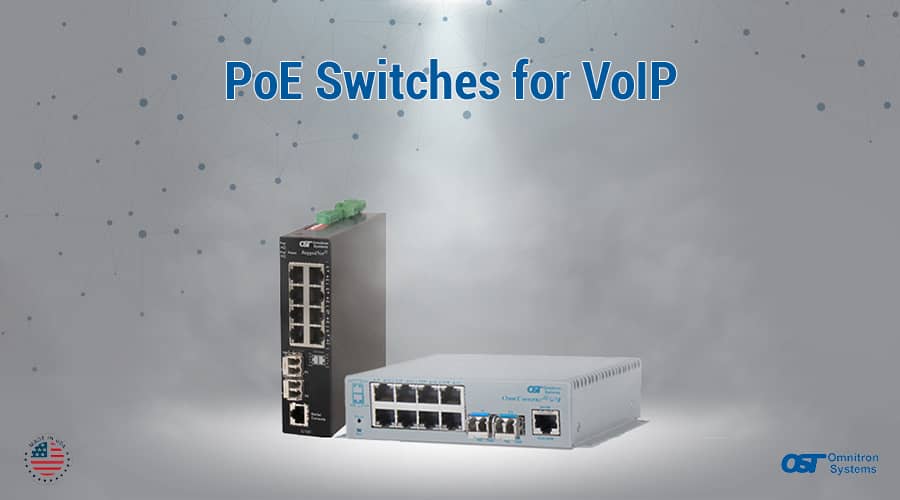
| PoE types | IEEE standard | power output | Power provides | Application |
|---|---|---|---|---|
|
PoE |
IEEE 802.3af |
15.4W |
12.97W |
VOIP phones |
|
PoE+ |
IEEE 802.3af |
30W |
25W |
IP cameras |
|
PoE++ |
IEEE 802.3bt |
60W |
51W |
LCDs, laptops |
|
Ultra PoE |
IEEE 802.3bt |
100W |
71W |
high-speed HD security cameras |
PoE Media Converters for VoIP
PoE media converters are mainly used when the VoIP (Voice over Internet Protocol) phones are located far from the Ethernet switch and the PoE switch. PoE media converters extend the PoE distance by converting copper to fiber and vice-versa. PoE media converters have one or two RJ-45 ports (10/100/1000BASE-T) and one or two fiber ports (100BASE-X (SFP), 1000BASE-X (ST, SC, SFP), 1000BASE-BX (SC, SFP)). The fiber transmits only data, so the fiber runs through the floors to reach the PoE media converters. It will then convert to UTP copper cabling to connect to the VoIP phone and send both power and data.

Managed or Unmanaged switch for VOIP
All unmanaged Ethernet switches, unmanaged PoE switches, and unmanaged PoE media converters are plug-and-play with auto-negotiation of data rates and duplex modes. They are easy to use but not practical for VoIP phones. It is important to be able to manage each port of the switch. Managed Ethernet switches, and managed PoE switches provide the right tools and methods for monitoring the network and prioritize channels to change the bandwidth or the data rate. This makes it possible to control network traffic. All Omnnitron managed Ethernet switches, and managed PoE switches, support VLAN capability to isolate VoIP traffic from other data traffic inside the network.
| Network devices | PoE types | Bandwidth | Ports |
|---|---|---|---|
|
Managed PoE Switch |
PoE/ PoE+ |
10G |
Four or eight 10/100/1000 RJ-45 PoE/PoE+user ports Two 1/10G SFP/SFP+ transceiver uplink ports |
|
Managed PoE Switch |
PoE++/ HPoE |
10G |
Four 10/100/1000 copper 60W or 100W PoE user ports Two 1/10G SFP/SFP+ transceiver uplink ports |
|
Managed PoE Switch |
PoE/ PoE+ |
1G |
Four or eight 10/100/1000 copper PoE+ user ports Two 10/100/1000 copper or Gigabit fiber uplink ports |
|
Managed PoE Switch |
PoE++/ HPoE |
1G |
Four 10/100/1000 copper PoE user ports Two 10/100/1000 copper or Gigabit fiber uplink ports |
|
Managed Ethernet switch |
- |
10G |
Eight or four 10/100/1000 copper user ports Two 10G SFP/SFP+ transceiver uplink ports |
|
Managed Ethernet switch |
- |
1G |
Eight or four 10/100/1000 RJ-45 copper user ports two 1/10G uplink ports. |
|
Unmanaged PoE Media Converters |
PoE/ PoE+ |
1G |
1 or 2 RJ-45 ports (10/100/1000BASE-T) 1 or 2 Fiber ports (100BASE-X (SFP), 1000BASE-X (ST, SC, SFP), 1000BASE-BX (SC, SFP)) 10/100/1000 Media Converter with Power over Ethernet (PoE or PoE+) |
|
Unmanaged PoE Media Converters |
PoE++/ HPoE |
1G |
1 or 2 RJ-45 ports (10/100/1000BASE-T) 1 or 2 Fiber ports (100BASE-X (SFP), 1000BASE-X (ST, SC, SFP), 1000BASE-BX (SC, SFP)) 10/100/1000 Media Converter with Power over Ethernet (60W and 100W PoE) |
|
Unmanaged PoE Media Converters |
PoE/ PoE+ |
1G |
1 or 2 RJ-45 ports (10/100BASE-T) 1 or 2 Fiber ports (100BASE-X (ST, SC, SFP),100BASE-BX (SC, SFP)) 10/100 Media Converter with Power over Ethernet (PoE or PoE+) |
Omnitron CoS/QoS Feature for VoIP Networks
The CoS/QoS feature is available on managed switches. The CoS / QoS provides the ability to configure class of service profiles. Class of service (CoS) is supported by mapping customer frames into eight egress queues based on using the 3-bit Priority Code Point (PCP) field in the VLAN tag. Enabling the quality of service (QoS) feature prioritizes high-priority voice traffic over other data traffic and guarantees uninterrupted voice conversation.
Omnitron Networking Solutions for VoIP
Fiber-optic cables are installed to offices and cubicles, where they are terminated by OmniConverter PoE Media Converters and PoE Fiber Switches that are powered by AC or DC power sources. The PoE media converters and PoE fiber switches provide fiber-to-copper media conversion, plus PoE via UTP cabling for up to eight PoE Powered Devices (PDs). OmniConverter PoE media converters and PoE switches automatically negotiate the required PoE power level with the attached PD and detect whether or not a connected device is a PoE PD, so non-PD devices can also be safely connected.
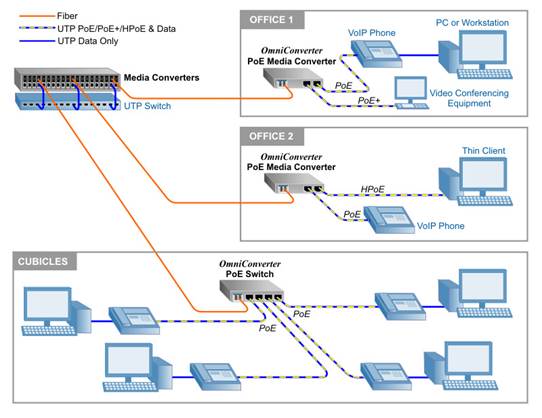
In OFFICE 1, the OmniConverter media converter has two RJ-45 ports that provide PoE to an IP phone and PoE+ to video conferencing equipment. A desktop PC is tethered to the IP phone and receives data only over the UTP cable.
In OFFICE 2, the OmniConverter media converter has two RJ-45 ports that provide HPoE to a thin client and PoE to a VoIP phone.
In the CUBICLES, an OmniConverter PoE switch provides PoE to four (and up to eight) VoIP phones with tethered PCs that receive data only over the UTP cable.
FAQ
Here are the most asked questions that you might also run into:
Can I Run VoIP Phones Through an Unmanaged Switch?
Unmanaged switches, like unmanaged Ethernet switches, unmanaged PoE switches, and unmanaged PoE media converters, are plug-and-play switches without remote configuration and monitoring. They cannot support QoS or VLAN. The answer is yes, but unmanaged switches are not as practical but are very economical for VoIP systems. On the other hand, managed switches are more secure, suitable, and ideal for VoIP deployments.
What are the Best Switches for VoIP Networks?
Choosing the best VoIP switch can be challenging. If your VoIP phone is a non-PoE device, a 1 or 10-gigabit managed Ethernet switch is the best. If the VoIP phone is a powered device (PD), a 1 or 10-gigabit managed PoE switch is the most practical switch. If you want to extend the distance beyond 100 meters then a PoE media converter can come in handy to cover the distance with fiber and provide the power to the VoIP phone via the copper ports. The question that you need to ask yourself is: What are my network needs? Depending on the needs pick the appropriate solution as outlined above.
How/Where Do I Plug in a VOIP Phone?
Most VoIP phones have two ports: one WAN port and one LAN port.
- The LAN port connects the desktop computer or Notebook
- The WAN port connects the VoIP phone to the LAN Ethernet switch.
Will a VoIP Phone System Work Without the Internet? / Does VoIP Work if the Internet is Down?
VoIP requires an internet connection, but it entirely depends on how the VoIP system is configured. If there is no internet connection, the VoIP phones will work as an intra office phone system. You are able to call other extensions inside the LAN but not outside.
If you utilize VoIP for the home and subscribe to get the VoIP service through an internet connection, you'll be affected when the internet is inaccessible. When ATA (analog telephone connector) registers on a VoIP phone, the phone is prepared to make a call and receive one.
On the other hand, if VoIP is arranged in corporate settings, like in an organization or office associations to the public switched telephone network (PSTN), the internet going down does not have an impact. If the VoIP is outside the office or the organization when the internet connection is down, each association will go down with it. Most organizations have reinforcement and auxiliary internet connections to decrease the hazard of a total outage.
Is VoIP Only Used in LAN?
No, VoIP (Voice over Internet Protocol) is a technology that requires the internet connection to be used for calling all around the globe, both inside and outside the LAN.
Conclusion
When it comes to selecting the best network device to connect VoIP networks, you can choose between managed or unmanaged Ethernet, PoE Switches, and PoE media converters. Omnitron’s managed 1Gigabit or 10Gigabit PoE switches are the most practical solution for extending data and PoE power to VoIP phones. If you are still unsure about which products to select for your VoIP system, contact Omnitron Systems’ technicians to receive pre-sale network design support. We are available 24 hours a day, 7 days a week, and 365 days a year to answer your questions. Contact us today.









